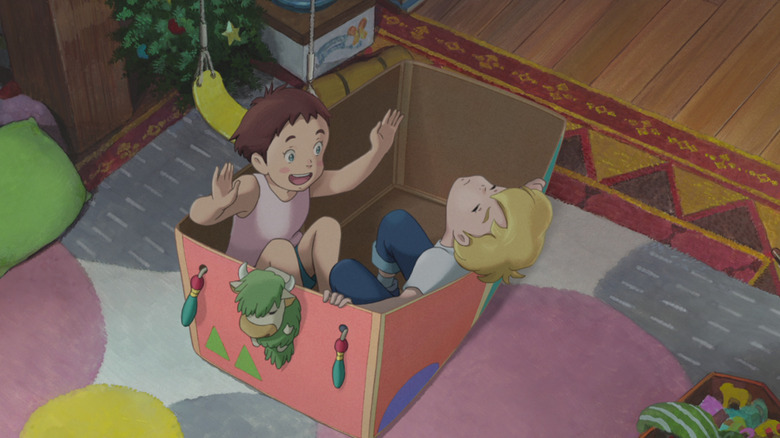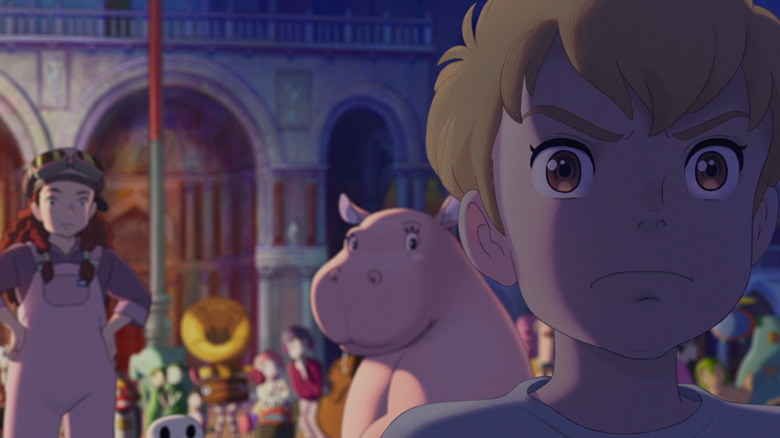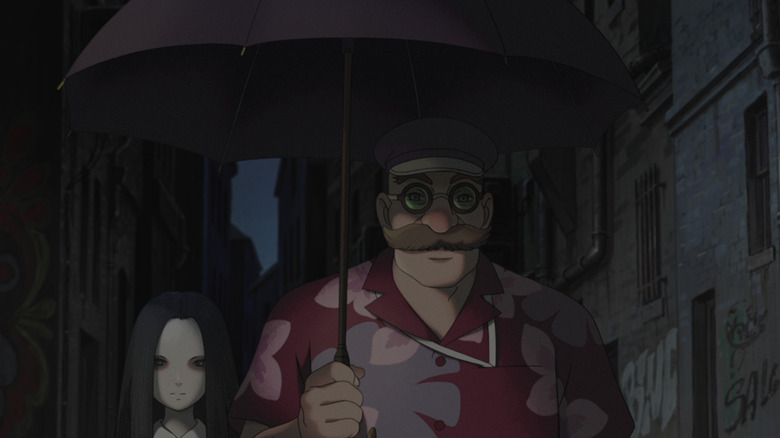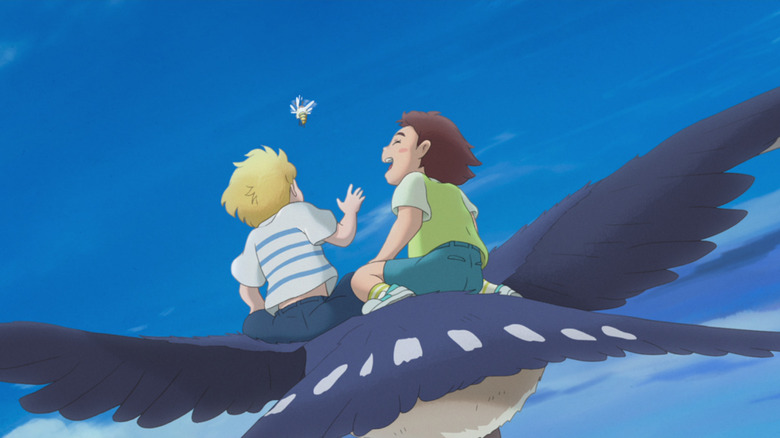The Imaginary Review: Netflix And Studio Ponoc Deliver A Gorgeous Generational Classic In The Making
Lonely Amanda Shuffleup imagined her best friend Rudger (no, not Rodger, Rudger, thank you) three months, three weeks, and three days ago. They made a promise to each other that no matter what happens, they'll never disappear, protect each other, and never cry. The two spend their days flying through the sky on the back of a giant sparrow, visiting the chatty squirrel, admiring the ocean whale (that's a whale made of ocean), and trying not to get caught by a giant snow beast when drifting through a winter wonderland.
To Amanda's mother, it's nothing more than imaginative play, but for Amanda and Rudger, each adventure brings a fully realized world to life. Her creative mind makes Rudger a special imaginary friend, one that makes him the target for an evil adult who can see Imaginaries named Mr. Bunting, a Hawaiian shirt-clad creep who physically eats imaginary friends to maintain a connection with his longtime imaginary friend — a girl who "smells like rot and is cold as an icicle" and looks like she just stepped out of a Japanese horror movie from the 2000s. In any other movie, Mr. Bunting and his imaginary friend would be the only conflict for a film courting young audiences to process, but Studio Ponoc — like founder Yoshiaki Nishimura's former home Studio Ghibli — knows better than to soften the edges of dark, serious themes for children.
Sometimes you watch a film and know the moment the credits roll that you've witnessed something special, one that will become a beloved favorite and be passed down for years to come. "The Imaginary" is that film for 2024, a breathtaking feat of animation with a powerful story that lends it to being a generational classic in the making.
An imaginary friend without someone to imagine him
Very early into "The Imaginary," tragedy strikes. Amanda is hit by a car while running through a parking lot and is taken away in an ambulance, leaving Rudger without his friend — without someone to imagine him. Now at the risk of being forgotten forever, he's rescued by Jinzan (Zinzan in the English dub), a cat with heterochromia that serves as a guide between the Imaginaries and the real world. When not out helping children, Imaginaries live in the library during business hours because "imagination is the oxygen of the Imaginaries," and libraries are filled with imagination. Rudger quickly makes friends with Snowflake the pink hippopotamus, Cruncher-of-Bones (a little skeleton that is also a slot machine that gifts candy), and Emily, who also looks human but has overalls with a built-in glide cape like a flying squirrel.
He tries to warn his new friends of the threat of Mr. Bunting and claims his Amanda is still alive and capable of remembering him, but they think he's just struggling to accept his new reality. The real world can't see him and the Imaginaries don't believe him, making Rudger feel trapped between two worlds. There's a heaviness that runs through "The Imaginary," constantly pulling this stunning odyssey of colorful, creative adventures down to earth. There's plenty of whimsy to be found, especially when the Imaginaries take up "day jobs" or short-term play with children requiring imaginary friends for a one-off game. If they're lucky, they might reincarnate into a brand new, full-time imaginary companion. But Rudger doesn't want to become someone else's imaginary friend, he wants to save Amanda. His perseverance is not just admirable, but the beating heart of the entire film.
"It's difficult to be forgotten, but it's something that will happen to us all sooner or later," Jinzan tells him. That may be true, but Rudger isn't ready yet. Amanda still needs him, and he knows it.
The successor to 1980s fantasy adventure films
"The Imaginary" is bursting with gorgeous scenes set in storybook worlds or the imaginative thoughts of children, with giant trees exploding into rainbow origami cranes and a giant space battle as two truly dazzling examples. But that heaviness brings a darkness to the more surreal moments, ones that evoke a similar feeling to watching "The Neverending Story," "Return to Oz," or "The Last Unicorn." This is not a sanitized look at childhood by any means but is still age-appropriate not because it provides a soft landing, but because it gives the audience the tools to make their own.
As Emily explains to Rudger, "We make humans and their world more beautiful," which means there has to be some ugliness to justify the existence of imaginary friends. Why do children create imaginary friends? Well, whether it's "Drop Dead Fred" or "Foster's Home for Imaginary Friends," imaginary friends are a support system for children.
Sometimes they're an outlet for creativity, sometimes they're cures to loneliness, and sometimes they're coping mechanisms for when life gets too tough to deal with on your own. They're an extension of the ways our minds try their hardest to keep us safe by imagining better worlds for us to live in, better people for us to meet, and sometimes scarier situations so we can practice getting through them for when we must face the real thing.
Rudger would do absolutely anything to ensure Amanda has a life as pain-free as humanly possible and refuses to give up on her. Considering he's a figment of her imagination, it's a touching reminder that we do have a little bit of control over our emotional well-being. Sure, life can get us down (and plenty of us have chemical imbalances), but fantasy and fright are both a part of life, and childhood is the best time for us to prepare for those futures.
The best imaginary friend film of the year
While "The Imaginary" is based on the 2014 British children's novel written by A. F. Harrold and illustrated by Emily Gravett, the film was released in Japan under the title "Rudger in the Attic." Given the Blumhouse horror film "Imaginary" and John Krasinski's imaginary friend flick "IF," both coming out this year, I wish they'd have gone with the Japanese title because I am terrified that "The Imaginary" will get swallowed up by a combination of SEO hell and the already ridiculous stigma that general audiences (and plenty of professional critics if I'm being honest), have against anime. Last year "The Boy and the Heron" set a box office record for anime in the United States and took home the Oscar for Best Animated Feature, which should hopefully earn some goodwill for "The Imaginary." This is a film that demands to be seen by as many people as possible — regardless of age.
If there's any complaint to be found, it's that the rules of the Imaginaries may feel overly complicated at times, but in my opinion, this is a feature, not a bug. Imagination is messy, contradictory, and exploratory, so it makes sense that the rules would reflect that. The Ghibli comparison is inevitable but in a landscape overrun with non-confrontational, safe, stale animation algorithmically guaranteed not to upset the conservative applecart, having more films of this ilk is a net positive.
/Film Rating: 8.5 out of 10
"The Imaginary" premieres globally on Netflix on July 5, 2024, following a limited theatrical release on June 28, 2024.



